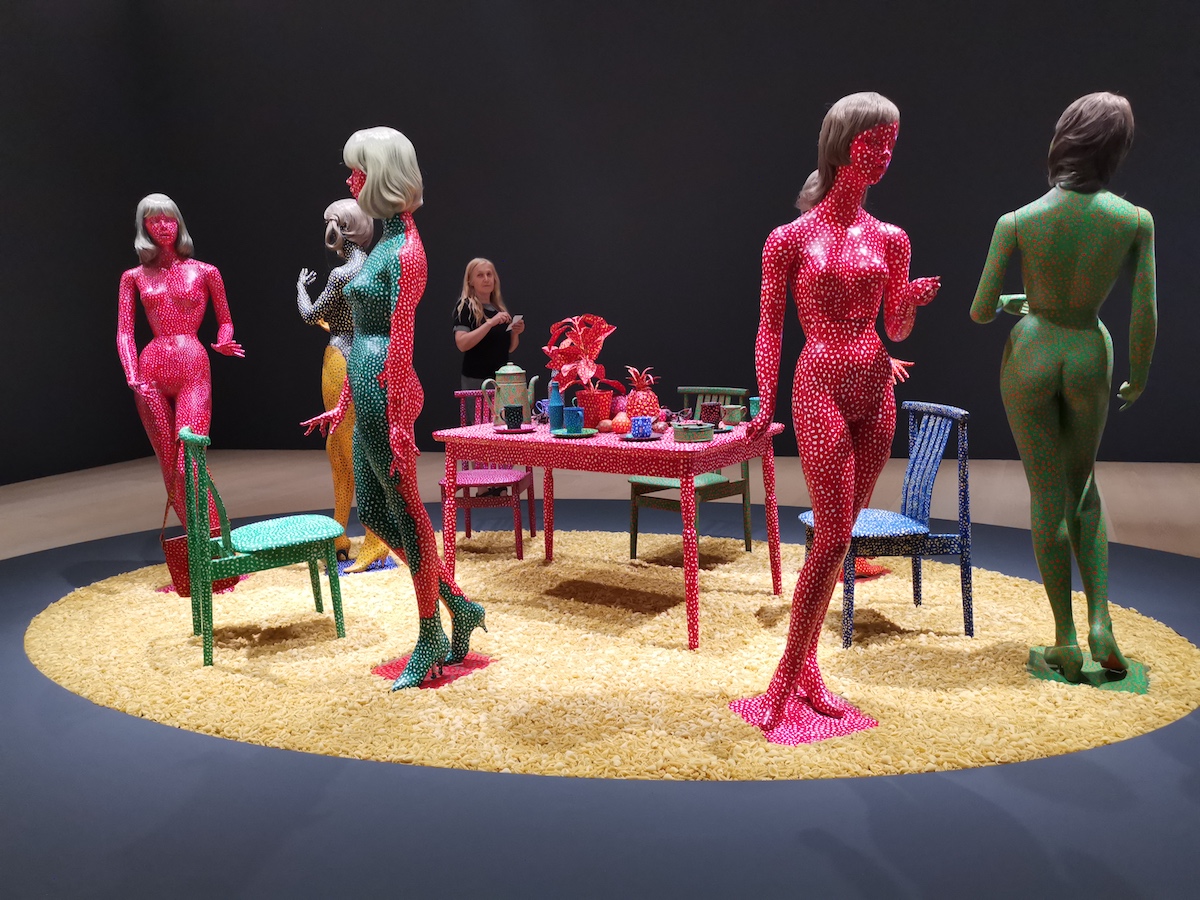Although Yayoi Kusama’s work has been on tour for some time, including a well-reviewed stint at the Tate Modern, I luckily had managed to avoid these shows. Luckily because this left me open to experiencing the Kusama for the first time at the Bilbao Guggenheim. This gave me an advantage over some of my fellow journalists who could compare this visit to previous ones.
Kusama’s work is intuitive and direct
This particular show was at the end of the exhibitions touring Kusama’s work. When questioned about where the show would go next, the reply was that this was the end of the journey in Bilbao and Hong Kong.
So it seems I was lucky again, and I urge others to take advantage of this final stage of a famous show. There is one of Kusama’s Infinity Mirrored Rooms to experience, albeit for a short burst in the way that the Guggenheim has managed this. These infinity rooms have become an important selfie opportunity for art visitors. And this fits Kusama’s video. We see ourselves erased in the particles of space, yet at the same time, we assert ourselves, becoming deliberately part of everything.
In some ways, the naive concentration of Kusama’s work does not appear to go into an adult appreciation of the cosmos. I find that although the declared themes which organise the work as part of this curation are grand indeed (Infinity. Accumulation. Radical Connectivity. Bioscomic. Death. Force of Life), the work makes no effort to decode contemporary scientific understandings of how things work. The idea is so simple, so visual, so uncomplicated it has a natural power. A leaf, a spot mimics the particles that cover the individual as it returns to infinity, the dust that covers a body in its grave, the stars that appear one by one and more and more, shining brighter and brighter as the lights of life go out. It is a child’s vision, grown older without maturing in terms of intellectual analysis. This is the power of Kusama’s work, it is intuitive and direct, and it is the limitations and repetitions that give it strength repeated in different media.

There is a paradox in Kusama’s success that is referred to by everyone who talks about her work: her deliberate separation of herself from society, a kind of contemporary immuration, despite her success in the art world. In 1973 she checked herself into Seiwa Hospital for the Mentally Ill, where she still resides. People are fascinated by her voluntary entry into an institution, and it’s a mysterious story because, somehow, the system worked so that she was able to continue to operate as a successful artist. She maintained that high level of self-recognition while being removed from the competitive nature of the struggles of the art world. That fact seems to draw the conversation around it outside the official interpretation of Kusama as an important artist because of her avant-garde influence and status. It gives a mystery that other self-reliant artists lack.
‘Is she an outsider artist?’ was a question that was raised to the curator, Doryun Chong, who answered with a yes and a no. No, not professionally, as she is a successful artist at the heart of the art establishment, with shows in such hallowed galleries as the Guggenheim in Bilbao and the Tate Modern. But yes, maybe in the type of work, the look of her work, and her approach to her work, many might think that she had much in common with work that is considered outsider art. I found the Q and A with Chong and others very important in finding a way to get a grip on Kusama’s identity as an artist. I was particularly struck by his interpretation of Kusama as a pioneer artist who was clear and open about her own mental health when few were so transparent.
For myself, there were a couple of items in the exhibition that I was drawn to. One was the film ‘Self-Obliteration’ from 1967, which felt like a classic of its era. It’s beautiful, gorgeously composed, paced, and embedded in that radical generation. But this one can even be viewed at home on the computer in a relatively immersive environment. The other was completely site-specific but was the application of the Guggenheim marketing team of Kusama’s classic red polka dots in the Guggenheim. These are called ‘mizutama (水玉) ‘ in Japanese, which also means water droplets. Large red dots were placed in the water around the Guggenheim. In turn, water droplets formed on the red dots in a way that mimicked the clouds of Kusama’s shapes, life imitating art. I was lucky again. I was standing outside when the steam clouds added atmosphere to the installation. It felt like one of those glorious moments of life imitating art, as Kusama’s art imitates life, the relationship of a human to its infinite home.
Yayoi Kusama: 1945 To Now, Bilbao Guggenheim, 27 June to 8 October, 2023
Visit Here

